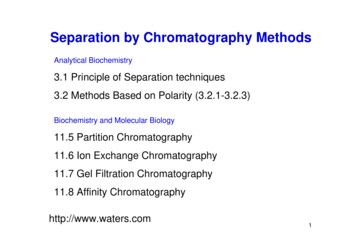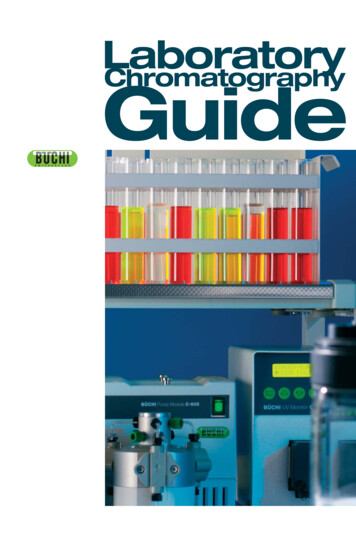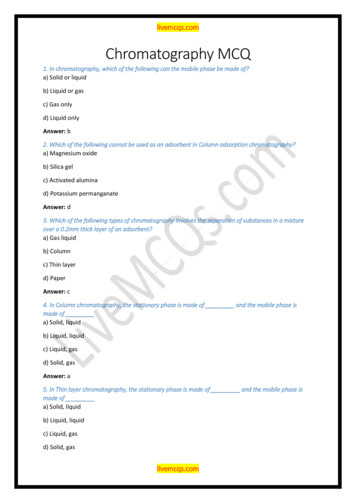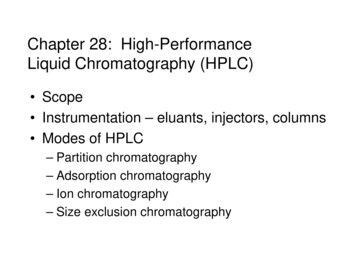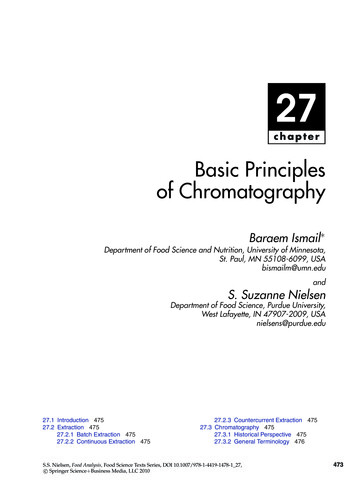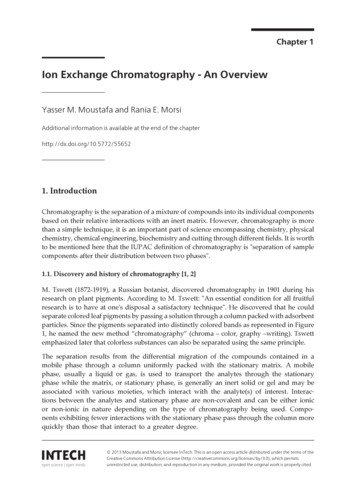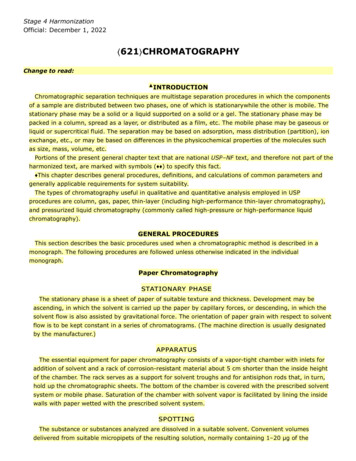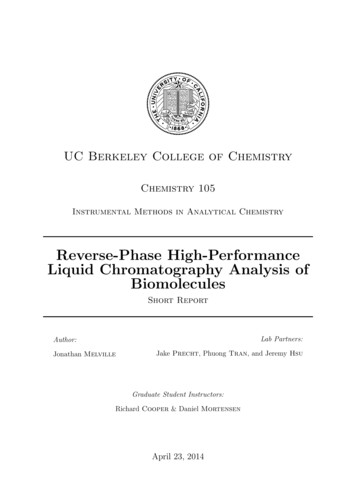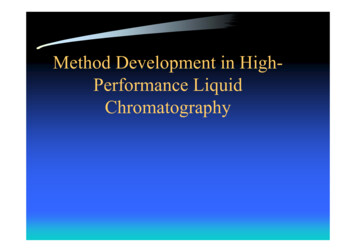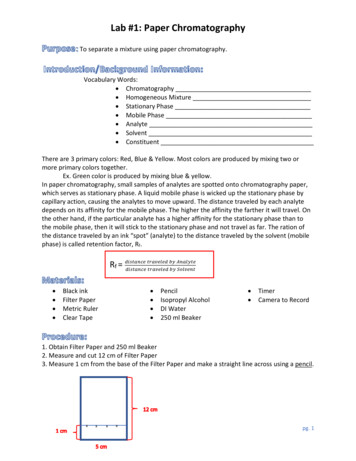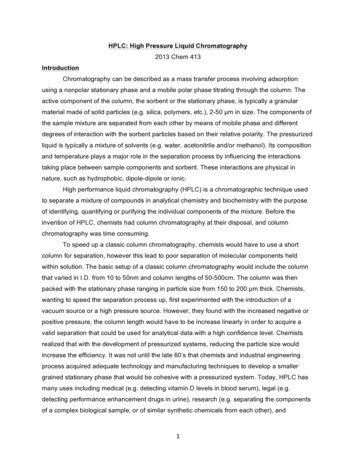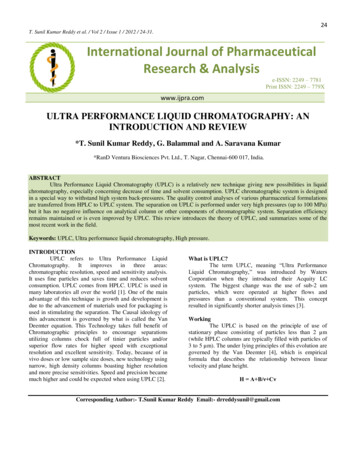
Transcription
24T. Sunil Kumar Reddy et al. / Vol 2 / Issue 1 / 2012 / 24-31.International Journal of PharmaceuticalResearch & Analysise-ISSN: 2249 – 7781Print ISSN: 2249 – 779Xwww.ijpra.comULTRA PERFORMANCE LIQUID CHROMATOGRAPHY: ANINTRODUCTION AND REVIEW*T. Sunil Kumar Reddy, G. Balammal and A. Saravana Kumar*RanD Ventura Biosciences Pvt. Ltd., T. Nagar, Chennai-600 017, India.ABSTRACTUltra Performance Liquid Chromatography (UPLC) is a relatively new technique giving new possibilities in liquidchromatography, especially concerning decrease of time and solvent consumption. UPLC chromatographic system is designedin a special way to withstand high system back-pressures. The quality control analyses of various pharmaceutical formulationsare transferred from HPLC to UPLC system. The separation on UPLC is performed under very high pressures (up to 100 MPa)but it has no negative influence on analytical column or other components of chromatographic system. Separation efficiencyremains maintained or is even improved by UPLC. This review introduces the theory of UPLC, and summarizes some of themost recent work in the field.Keywords: UPLC, Ultra performance liquid chromatography, High pressure.INTRODUCTIONUPLC refers to Ultra Performance LiquidChromatography. It improves in three areas:chromatographic resolution, speed and sensitivity analysis.It uses fine particles and saves time and reduces solventconsumption. UPLC comes from HPLC. UPLC is used inmany laboratories all over the world [1]. One of the mainadvantage of this technique is growth and development isdue to the advancement of materials used for packaging isused in stimulating the separation. The Causal ideology ofthis advancement is governed by what is called the VanDeemter equation. This Technology takes full benefit ofChromatographic principles to encourage separationsutilizing columns chock full of tinier particles and/orsuperior flow rates for higher speed with exceptionalresolution and excellent sensitivity. Today, because of invivo doses or low sample size doses, new technology usingnarrow, high density columns boasting higher resolutionand more precise sensitivities. Speed and precision becamemuch higher and could be expected when using UPLC [2].What is UPLC?The term UPLC, meaning “Ultra PerformanceLiquid Chromatography,” was introduced by WatersCorporation when they introduced their Acquity LCsystem. The biggest change was the use of sub-2 umparticles, which were operated at higher flows andpressures than a conventional system. This conceptresulted in significantly shorter analysis times [3].WorkingThe UPLC is based on the principle of use ofstationary phase consisting of particles less than 2 µm(while HPLC columns are typically filled with particles of3 to 5 µm). The under lying principles of this evolution aregoverned by the Van Deemter [4], which is empiricalformula that describes the relationship between linearvelocity and plane height.H A B/ν CνCorresponding Author:- T.Sunil Kumar Reddy Email:- drreddysunil@gmail.com
25T. Sunil Kumar Reddy et al. / Vol 2 / Issue 1 / 2012 / 24-31.Advantages of UPLCThe advantages of UPLC are: Decreases run time and increases sensitivity Provides the selectivity, sensitivity, and dynamicrange of LC analysis Maintaining resolution performance. Expands scope of Multiresidue Methods UPLC’s fast resolving power quickly quantifiesrelated and unrelated compounds Faster analysis through the use of a novel separationmaterial of very fine particle size Operation cost is reduced Less solvent consumption Reduces process cycle times, so that more product canbe produced with existing resources Increasessamplethroughputandenablesmanufacturers to produce more material that consistentlymeet or exceeds the product specifications, potentiallyeliminating variability, failed batches, or the need to re-velocities, flow rates and backpressures to obtain superiorresults.The Acquity UPLC system consists of Binary solvent manager Sample manager including the column heater Optional Sample manager Pumps DetectorBinary Solvent ManagerThe binary solvent manager uses two individualserial flow pumps to deliver a parallel binary gradient. Thebinary solvent manager is a high pressure pump that movessolvent through the system. It provides steady (pulse free)solvent flow at analytical flow rates. The binary solventmanager delivers solvent at flow rates of 1 ml/min at103421 Kрa [ 1034 bar, 1500 psi] and up to 2 ml/min atreduced pressures to 62053 Kpa [621 bar, 9000 psF] . Thesolvent manager can pump two solvents immediately.(27,28)work material Delivers real-time analysis in step with manufacturingprocesses Assures end-product quality, including final releasetestingUse of UPLC systemElevated-temperature chromatography also allowsfor high flow rates by lowering the viscosity of the mobilephase, which significantly reduces the columnbackpressure 9, 10. Monolithic columns contain apolymerized porous support structure that provides lowerflow resistances than conventional particle-packedcolumns [5-6].Disadvantages [7-11]The dis advantages of UPLC are Due to increased pressure requires more maintenanceand reduces the life of the columns of this type. So far performance similar or even higher has beendemonstrated by using stationary phases of size around 2μm without the adverse effects of high pressure. In addition, the phases of less than 2 μm are generallynon-regenerable.Draw Backs Cost mixing Solvent pumping Lack of variety in commericial columns at 1.7 µmInstrumentationThe Ultra Performance Liquid Chromatographyhave the ability to work more efficiently with higher speed,sensitivity and resolution at a much wider range of linearSample ManagerThe Acuity sample manager injects the sample itdraws from Micro titer plates or vials in to thechromatographic flow stream. A locating mechanism usesa probe to access sample locations and draw sample fromthem. The Sample manager can perform an injection inapproximately 15 seconds. The sample manager alsocontrols the column heater. Column temperatures up to65 С can be attained.Column HeaterThe column heater is of a modular design and itsfoot print is identical to that ofthe sample manager. Thus it attaches to the top of thesample manager and serves as thatinstrument’s top cover [12].Optional Sample OrganizerThe optional sample organizer stores micro miteror vial plates and transfers them to and from the samplemanages, automating their processing and increasingthrough put [13].PumpsThe UPLC pump is considered to be one of themost important components in a liquid chromatographysystem which has to provide a continuous constant flow ofthe eluent through the UPLC injector, column, anddetector.The two basic classifications are Constant pressure pump Constant flow pumpConstant pressure pump
26T. Sunil Kumar Reddy et al. / Vol 2 / Issue 1 / 2012 / 24-31.The constant pressure is used only for columnpacking.Constant flow pumpThis type is mostly used in all common UPLCapplicationsStandard UPLC pump requirements Sample injection volume is as less as 3 – 5 micro liters Pump operates at 10000 psi pressure Particle size in stationary phase packing material isless than 2 micro meterTypes of PumpsReciprocating Piston PumpsThe basic principle of the reciprocating singlepiston pumps is that it expels liquid through a one-wayvalve (check valve). The pumping rate is usually adjustedby controlling the distance the piston retracts, thus limitingthe amount of liquid pushed out by each stroke, or by thecam rotating speed. Schematic of the reciprocating singlepiston pump. CAM is pushing a sapphire piston back andforce. When the piston is moving backwards it sucks theeluent through the inlet check valve (on the bottom). Thesapphire ball is lifted and opens the path for the eluent.When the piston moves forward, the liquid pushes the inletball down and closes the path, but the outlet ball is liftedand opens the outlet valve (upper) [14-18].DisadvantageThe main disadvantage of this type of pump issinusoidal pressure pulsations which lead to the necessityof using pulse dampers.Dual Piston PumpsA more efficient way to provide a constant andalmost pulse free flow is the use of dual-headedreciprocating pumps. Both pump chambers are driven bythe same motor through a common eccentric cam; thiscommon drive allows one piston to pump while the other isrefilling. As a result, the two flow-profiles overlap eachother significantly reducing the pulsation downstream ofthe pump; this is visualized below. Since theacceleration/deceleration profile is somewhat non-linear,the more efficient types of these pumps use eccentricityshaped cams to obtain the best overlapping of the pressurecurves and to obtain smooth flow [19,21].Schematic of a dual-head reciprocating pumpsThe advantages of this pump are the unlimitedsolvent reservoir allowing long-term unattended use andquick changeover and clean out capability. However,unless special care has been exercised in manufacture,these pumps may have several disadvantages. There is atendency for the incompletely compensated pulsations tobe observable at high refractive index detector sensitivities,especially at low flow rates where piston cycles are widelyspread. Furthermore, since each head has two checkvalves, pump reliability depends on the cleanliness of themobile phase and continued sealing capability of fourcheck valves on each cycle, with cycles normally occurringseveral times per minute [20].Check valves on the reciprocating pump are theweakest part. It may be easily contaminated or cloggedwhich leads to the pump misfunction. Most of the recentHPLC instruments use improved dual piston pumps whichhave three or even two check valves.The schematic of this pump is shown above. Thefirst piston, called low pressure, is sucks the liquid fromthe reservoir while the second (high pressure piston) issupplying the eluent to the system. Then the first pistonrefills the second piston very fast, during 1/100 of thewhole pump cycle. This scheme allows the use of only 3check valve, one of which is working under low pressure.There are no cavitation effects. Because the piston volumesare small ( 100 l), pressure pulastions are small andsharp and easy to damp [22].Another type of dual piston pump uses only twocheck valves, but piston volumes are different. While thesmaller piston dispenses an eluent in the HPLC system, thebigger piston is sucking an eluent. When pistons changetheir direction, the bigger piston simultaneously refills thesmaller chamber and dispenses eluent into the system. Thisset-up allows only two check valves for the dual pistonpump [23].Detectors [21-26]Types of Detectors:Detectors can be classified as: Optical detectors Tunable ultra violet detectors Evaporative light scattering detectors Fluorescence detectorOptical Detectors:Optical Detectors are used in ultra performance liquidchromatography analytical techniques, featuring lowdispersion characteristics, simple operation , and high dataacquisition rates as well as cost effective maintenance ,support and parts.The system can be configured with a TUV, PDAor ELS optical detector or any combination of the three.Tunable Ultra Violet DetectorFor UPLC detection, the TUV [tunable ultraviolet] detector is used which includes new electronics andfirm ware to support . The TUV optical detector is a two
27T. Sunil Kumar Reddy et al. / Vol 2 / Issue 1 / 2012 / 24-31.channel ultra violet / visible absorbance detector designedfor the use of in the acquity UPLC system.The detector offers two flow cell options. Theanalytical cell flow , with a volume of 500 nano liters anda path length of 10 nm and the high sensitivity flow cellwith a volume of 2.4 micro litres and 25 mm path length ,both utilize the waters patented light guiding flow alltechnology.The TUV detector operates at wave lengthranging from 190 to 700 nm.Features Maximum signal-to-noise response enabled by lightguiding flow cell technology, which eliminates internalabsorption, for minimal bandspreading and maintainedconcentration High sensitivity for low-level detection forsimultaneous quantitation of major and minor componentsAcquity Uplc Els DectectorsThe ACQUITY UPLC ELS Detector with theACQUITY UPLC System lets you analyze more molecules(including sugars, triglycerides, phospholipids, antibiotics,and natural products) in a single analytical run.Anywhere large numbers of compounds arescreened rapidly – the detector offers a convenientstackable design, easy maintenance, and long lamplifetimes.The detector incorporates a flow type nebulizer thatis optimized for acquity UPLC system performanceFeatures1. Provides reproducible, reliable results with precisecontrol over nebulization and desolvation processes for themeasurement of temperature-sensitive molecules2. Ensures the benefits of UPLC performance across theentire flow rate range with high data capture rates3. One nebulizer for the entire flow rate range providessimplified set-up and the benefit of maximizedperformance.Acquity Uplc Flr DetectorThe ACQUITY UPLC Fluorescence (FLR)Detector delivers sensitivity and selectivity tofluorescence-based applications. Transfer your HPLCfluorescence methods to UltraPerformance LC for greaterthroughput without compromising sensitivity.Features1. Advanced optical design to maximize lightthroughput, and reduce light scatter, allowing for bettersignal-to-noise performance2. Intuitive system console provides simple navigation tomanage instrument parameters for easy system control3. Intuitive software interface and diagnostic tools instillconfidence that the detector is performing optimally.Injectors of UPLC [27,28]The injector is comprised of six miniature airactuated needle valves, plumbed to simulate the flow pathof a conventional rotor/stator injector. An integralcontroller sends the on/off positioning signals to eachvalve, coordinating them to perform load, inject, and flushfunctions.There are three methods for sending positioningcommands to the injector: Manual control with the pushbuttons on the controller Laboratory computer via serial port communication Contact closure inputsMigrating methods From HPLC to UPLCUltra performance liquid chromatography takesadvantage of small 1.7 µm particles operated at elevatedpressures to achieve un compromised separation speed ,resolution, and sensitivity .Selecting the Right columnA 1.7µm particle packed column providessignificant improvements in resolution because efficiencyis better. Separation of the components of a sample,however, still requires a bonded phase that provides bothretention and selectivity. Four bonded phases are availablefor UPLC separations ACQUITY UPLCBEH C18and C (straight8chain alkyl columns), ACQUITY UPLC BEH Shield RP18(embedded polar group column) and ACQUITY UPLCBEH Phenyl (phenyl group tethered to the silylfunctionality with a C alkyl) as shown in Figure 1. Each6column chemistry provides a different combination ofhydrophobicity, silanol activity, hydrolytic stability andchemical interaction with analytes.ACQUITY UPLC BEH C and C columns were188designed to be the universal columns of choice for mostUPLC separations by providing the widest pH range.Differences between UPLC and HPLC [29]The short information between HPLC and UPLC.HPLC Broader peak width provides less resolution Less sample throughput comparatively. Sample injection volume is 20 micro liters. Pump operates at 2000-6000 psi pressure Particle size in stationary phase packing material isbetween 5-12 micrometers.UPLC Smaller peak width provides better resolution andmore number of peaks getting identified.
28T. Sunil Kumar Reddy et al. / Vol 2 / Issue 1 / 2012 / 24-31. Higher sample throughput with more information persample. Sample injection volume is as less as 3-5 micro liters. Pump operates at 10,000 psi pressure Particle size in stationary phase packing material isless than 2 micrometer APPLICATIONS [26,30]Drug Discovery UPLC improves the drug discovery process by meansof high throughput screening, combinational chemistry,high throughput in vitro screening to determinephysiochemical and drug’s pharmacokinetics.High throughput quantitative analysis UPLC coupled with time of flight mass spectroscopygive the metabolic stability assay.Analysis of Dosage form It provides high speed, accuracy and reproducibleresults for isocratic and gradient analysis of drugs and theirrelated substance. Thus method development timedecrease.Analysis of amino acids UPLC used from accurate, reliable and reproducibleanalysis of amino acids in the areas of proteincharacterizations, cell culture monitoring and thenutritional analysis of foods.Determination of Pesticides UPLC couples with triple Quadra-pole tandem massspectroscopy will help in identification of trace level ofpesticides from water. Thus Ultra Pressure Liquid Chromatography set a newstandard in the science of chromatography. Working rangewith 15000 to 16000 psi pressure and column packed withless than 2 micrometer in size helped in various fields.Analysis of Natural Products and Traditional HerbalMedicine UPLC is widely used for analysis of natural productsand herbal medicines. The main purpose of this is toanalyze drug samples arise from the complexity of thematrix and variability from sample to sample. UPLCprovides high-quality separations and detection capabilitiesto identify active compounds in highly complex samplesthat results from natural products and traditional herbalmedicines.Identification of Metabolite UPLC/MS/MS addresses the complex analyticalrequirements of biomarker discovery by offeringunmatched sensitivity, resolution, dynamic range, andmass accuracy.ADME (Absorption, Distribution, Metabolism,Excretion) Screening The high resolution of UPLC enables accuratedetection and integration of peaks in complex matrices andextra sensitivity allows peak detection for samplesgenerated by lower concentration incubations and samplepooling. UPLC/MS/MS provides following advantages:UPLC can more than double throughput with no loss inmethod robustness. UPLC is also simpler and more robustthan the staggered separations sometimes applied withHPLC methods. UPLC operating with rapid, generic gradients hasbeen shown to increase analytical throughput andsensitivity in high throughput pharmacokinetics orbioanalysis studies, including the rapid measurement ofpotential p450 inhibition, induction, and drug-druginteractions.Bioanalysis / Bioequivalence StudiesUPLC delivers excellent chromatographic resolution andsensitivity. The sensitivity and selectivity of UPLC at lowdetection levels generates accurate and reliable data thatcan be used for a variety of different purposes, includingstatistical pharmacokinetics analysis. UPLC solutions areproven to increase efficiency, productivity and profitabilityfor bio equivalence laboratories.Dissolution TestingFor quality control and release in drugmanufacturing, dissolution testing is essential in theformulation, development and production process. UPLCprovides precise and reliable automated online sampleacquisition. It automates dissolution testing, from pill dropto test start, through data acquisition and analysis ofsample aliquots, to the management of test resultpublication and distribution.Method Development / ValidationAccording to FDA, validation is defined as establishingdocumented evidence that provides a high degree ofassurance that a specific process will consistently producea product meeting its predetermined specifications andquality attributes UPLC help in critical laboratory functionby increasing efficiency, reducing costs, and improvingopportunities for business success. UPLC provideefficiencies in method development. Using UPLC, analysistimes become as short as one minute, methods can beoptimized in just one or two hours, significantly reducingthe time required to develop and validate.
29T. Sunil Kumar Reddy et al. / Vol 2 / Issue 1 / 2012 / 24-31.Fig 1. IMAGE OF ULTRA PERFORMANCE LIQUIDCHROMATOGARPHYFig 2. ULTRA PERFORMANCE LIQUIDCHROMATOGRAPHY (UPLC)Fig 3. Sample Chromatogram of UPLCFig 4. Reciprocating Piston PumpsFig 5. Dual Piston Pumps
30T. Sunil Kumar Reddy et al. / Vol 2 / Issue 1 / 2012 / 24-31.Fig 6. dual-head reciprocating pumpCONCLUSIONUPLC increases productivity in both chemistry andinstrumentation by providing more information per unit ofwork as it gives increased resolution, speed, and sensitivityfor liquid chromatography. The main advantage is aFig 7. Differences between UPLC and HPLCreduction of analysis time, which also meant reducedsolvent consumption. UPLC can offer significantimprovements in speed, sensitivity and resolutioncompared with conventional HPLC.REFERENCES1. Jerkovich AD, Mellors JS and Jorgenson JW. LCGC, 21(7), 2003; 660-611.2. Wu N, Lippert JA and Lee ML. J. Chromatogr., A, 2001, 1-12,911.3. Unger KK, Kumar D, Grun M, Buchel G, Ludtke S, Adam Th, Scumacher K and Renker S. J. Chromatogr., A, 892(47),2000, 56-80.4. Swartz ME and Murphy B. Lab Plus Int., 18(6), 2004.5. Swartz ME and Murphy B. Pharm. Formulation Quality, 6(5), 2004, 40.6. Van Deemter JJ, Zuiderweg EJ, Klinkenberg A. Longitudinal diffusion and resistance to mass transfer as causes of nonideality in chromatography. Chem. Eng. Sci., 5, 1956, 271-289.7. Zhang YH, Gong XY, Zhang HM, Larock RC and Yeung ES. J. Comb. Chem., 2, 2000, 450-452.8. Zhou C, et al. Pharmac. Sci., 94, 2005, 576-589.9. Zhu J, et al. LCGC, 23(1), 2005; 54-72.10. Greibrokk T and Andersen T. J. Chromatogr. A, 1000, 2003; 743-755.11. Gerber F. et al. J. Chromatogr. A, 1036, 2004; 127-133.12. Tanaka N. et al. Anal. Chem., 73, 2001, 420A-429A.13. Wu N. et al. Anal. Chim. Acta., 523, 2004, 149-156.14. Swartz ME. Ultra Performance Liquid Chromatography (UPLC): An Introduction, Separation Science Re-Defined, LCGCSupplement, 2005, 8.15. Jerkovich AD. et al. LCGC, 21(7), 2003, 600-610.16. MacNair J.E. et.al. Anal. Chem. 1997; 69: 983-989.17. Colon LA, Citron JM, Anspach JA, Fermier AM, Swinney KA. Analyst, 129, 2004, 503.18. Michael E Swartz. UPLC: An Introduction and Review. Journal of Liquid Chromatography & Related Technologies, 28,2005, 1253-1263.19. MacNair JE. et al. Anal. Chem., 71, 1999, 700-708.20. Jeff Mazzeo, Tom Wheat, Beth Gillece-Castro, Ziling Lu. Next Generation Peptide Mapping with Ultra PerformanceLiquid Chromatography. BioPharm International, 19(1), 2006, 56-80.21. Swartz ME. Ultra Performance Liquid Chromatography (UPLC): An Introduction, Separation Science Re-Defined, LCGCSupplement, 2005, 12.22. Lars Y and Honore HS. J. Chromatogr., A, 1020, 2003, 59-67.23. McLoughlin D.A. et.al; Pharm. Biomed. Anal. 1997; 15: 1893-1901.24. Swartz ME. Ultra Performance Liquid Chromatography (UPLC): An Introduction, Separation Science Re-Defined LCGCSupplement, 2005, 11.
31T. Sunil Kumar Reddy et al. / Vol 2 / Issue 1 / 2012 / 24-31.25. Lippert JA. et al. Microcolumn Sep., 11, 1997, 631-643.26. Nguyen DT, Guillarme D, Rudaz S, Veuthey JL. “Fast analysis in liquid chromatography using small particle size andhigh pressure. J Sep Sci., 29(12), 2006, 1836-48.27. Jerkovitch AD. et.al. LCGC 2003.28. Goodwin L, White SA, Spooner N. Evaluation of ultra-performance liquid chromatography in the bioanalysis of smallmolecule drug candidates in plasma. J. Chromatogr. Sci., 45(6), 2007, 298-304.29. Swartz M. LCGC, 23(1), 2005, 46-53.30. Broske AD. et al. Agilent Technologies application note 2004, 5988-9251EN.
Ultra Performance Liquid Chromatography (UPLC) is a relatively new technique giving new possibilities in liquid chromatography, especially concerning decrease of time and solvent consumption. UPLC chromatographic system is designed in a special way
